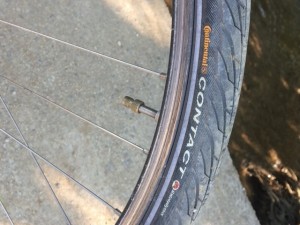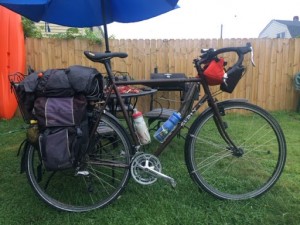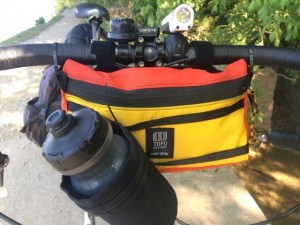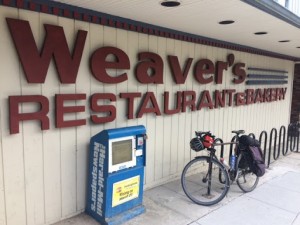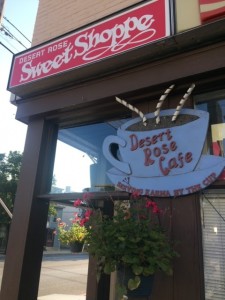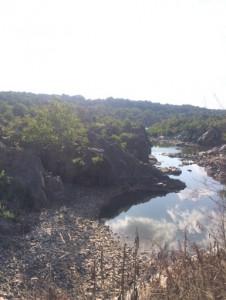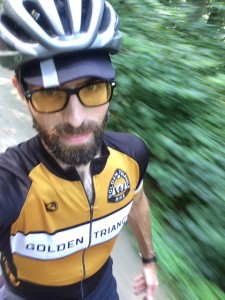- December 31, 2019
Bikepacking from Pittsburgh to DC in Three Days
Bikepacking from Pittsburgh to DC in Three Days
Notes on a cannonball run
A wise person would tell you to take your time riding the historic Great Allegheny Passage and C&O Canal Towpath, a combined 334 mile route from Pittsburgh,PA to Washington D.C. A wise person would tell you that you’d have more fun going with some riding buddies instead of alone. A wise person might also tell you to take at least six days and stay in the many cozy bed-and-breakfasts and hotels along the way. I am not that wise person.
I am, however, a mechanic at a busy tour outfitter, Golden Triangle Bikes, so time during the season is at a premium and that means doing the trip as quickly as possible. What follows is a guide to doing the Great Allegheny Passage and C&O Canal Towpath in three days camping every night.
When planning your trip, keep an eye on conditions for The Great Allegheny Passage (or GAP) and The C&O Canal Towpath. Note that Spring and Fall have milder temperatures, but can also be quite wet. Wet conditions can lead to landslides and washouts that may lead to detours. I recommend going in June, July, or August as that’s when days are longest and conditions tend to be dryer. Make sure to inform yourself of any closures and detours before you leave!
What follows is my non-exhaustive walkthrough of my three day trip from Pittsburgh to Washington D.C. to help you plan your own!
Preparation:
Training:
If you’re doing the math you’ll see that 334 miles in three days makes over a century of riding each day. I’d recommend training by doing some long rides leading up to a century in the months leading up to your tour. You don’t have to do this on your touring rig, but doing so will help you get your riding position dialed in. You may want to take some short trips with your bike loaded down (this could just be to the grocery store) to get a feel for how it handles. Don’t feel like you need to load your whole bike up for all of your training rides!
The Itinerary:
I attempted to break the 334 mile trip into three equal length legs with a campsite as my destination on the first two nights, and stayed with a friend in DC. I left on a Wednesday with the goal of arriving in DC on Friday. Here is my daily itinerary:
| Leg | Distance | Accomodation |
| Day 1: Pittsburgh,PA to Rockwood,PA | 106 miles | Husky Haven Campground, 440 Water St, Rockwood, PA 15557 |
| Day 2: Rockwood,PA to Clear Spring,MD | 114 miles | North Mountain Hiker Biker Campsite, and Canal, Clear Spring, MD 21722 |
| Day 3: Clear Spring,MD to Washington D.C. | 114 miles |
The Bike:
My trusty Surly Cross Check cross/touring bike is set up with a triple front chainring (52/42/30) and nine speed rear cassette (11-34.) It is very close in spec to the Surly Long Haul Trucker that our shop rents out. I recommend using a cross, gravel, touring, hybrid, or mountain bike as long as it has mounts for a rear rack. Suspension is not necessary for the GAP although a suspension fork on the C&O can help tame the many bumps on the trail. A full-suspension bike is likely more trouble than it’s worth as the frame suspension will suck up much of your seated pedaling power. What’s more, full-suspension bikes typically have no rack mounts and little space for water bottles.
Tires:
When doing the ride you will want tires of at least 28mm width for the GAP and at least 32-35mm for the C&O Canal Towpath. The Towpath can get quite bumpy with lots of roots, rocks, and potholes, so the wider the better here.
I used 700 x 35 Continental Contact Tour’s and had no problems. Note: the C&O can get quite muddy after heavy rains, and a knobbier tire would be useful here. That said, a tire wider than 2.5” (60mm) is likely too heavy or sluggish to be worth the trouble. (i.e. don’t bring your fat bike.) Use tires in good condition with decent flat protection- you don’t want to fight flat tires the whole ride!
Bags:
There are seemingly infinite ways to carry luggage on your bike, but I am a traditionalist so I typically use a rear rack, two panniers, and a handlebar bag. A frame bag or seat bag is not a bad idea, but also not necessary. Front-loading seems to be all the rage these days, but I find the bike handles better if I keep most of the weight off the front end (this helps with hands-free riding!) A handlebar bag is sufficient for carrying a phone, snacks, multitool and other easy access items. I used an All-City Gorilla Monsoon bag. One last note on panniers, even if advertised as waterproof or water resistant, bring some trash bags to keep your stored clothing dry if it rains. A small dry bag or sandwich bag is sufficient to keep your phone dry. Be mindful of jersey pockets which can cover your phone in perspiration during a long ride.
The rig fully loaded
Topo/All-City handlebar bag with bottle pouch added
Gear:
An advantage and prerequisite for doing the trip quickly is not carrying too much stuff! I’d recommend going in July or August when it is warmest, so you don’t need to pack as much clothing. Check the weather to know whether you’ll need to bring rain gear and/or a waterproof tent. I luckily picked a dry stretch to go, so went without a tent. What follows is a bare-bones list of what to bring:
Camping Gear:
- Hammock and rainfly (I used a Grand Trunk hammock that was very lightweight and easy to set up.) Or Tent (if it’s raining.)
- Sleeping Bag
- Tent Footprint or Tarp (these can help keep your tent dry or double as a shelter/blanket if it starts pouring
- Headlamp
- Cookery don’t bother. Bring trail mix and fruit or energy bars to eat while riding. Real food and coffee can be purchased in the towns you stop through.
- Insect Repellant
- Sunscreen
- Ibuprofen (I am 38 after all.)
- Toothbrush and toothpaste
- Deodorant
- Small first aid kit (this could just be a few band-aids and neosporin)
- Water bottles At least two (mounted on the bike.) If you have room for a third go for it. A camelback is not a bad idea, but don’t think you need to lug all of your water. There are many places to refill your bottles along the route.
Clothing:
- Padded shorts or bibs A wise man once said “this is a seated event.” You will spend a lot of time on your butt, so treat it right with padded shorts and maybe even chamois cream to reduce friction.
- Underwear so you don’t have to sleep in your chamois
- Riding Gloves while doing long days on the trail your hands will appreciate the shock absorption!
- Jerseys or comfortable t-shirts A wicking cycling jersey is nice to have (especially for the pockets), but not necessary. Either way, light and comfortable is key. Bring a set of bibs and jerseys for each day riding unless you plan to launder them.
- Socks bring extra if it’s going to rain
- Outer shorts not necessary, but they make me feel better when I walk into a restaurant after a day of riding. That said, the local businesses are quite used to seeing people in lycra.
- Windbreaker for cold mornings and evenings
- Rain Jacket
- Shoes if using clipless pedals wear a mountain bike style (two bolt) shoe with tread for walking. Stiff racey shoes are not necessary, but make pedaling more efficient. Whatever shoe make sure it fits and is comfortable for long distances and near constant pedaling. I wore Bontrager Foray shoes. If wearing sneakers go with something that is supportive and comfortable.
Tools and Spare Parts
- Bike Lock chain, cable, or U-lock. The route is very safe, but don’t take chances when your bike is unattended.
- Cycle Computer mounted on the bike. This will make is easy for you to set and monitor your pace on the trail. GPS or navigation computers are not necessary, just one that gives you speed, distance, and average speed.
- Front and Rear Lights rechargeable or battery powered. You won’t need anything super bright unless riding after dark.
- Cell Phone Charger Cord and charged battery pack
- Hand Pump I recommend the Topeak Road Morph
- Two Spare Tubes for your correct tire size and valve type
- Two Tire Levers
- Patch Kit use the glue type not the self-adhesive
- A Couple spare spokes one for the front wheel, one for the rear
- A Multi Tool with allen wrenches (size 2.3,3,4,5,6,and 8), spoke wrenches, screwdrivers and chain tool. A Crankbrothers M19 has all of these
- A Master Link for your chain type (8,9,10,11 speed etc.)
- A spare set of brake pads
- A spare quick release skewer (in case you lose yours when fixing a flat tire)
- A spare brake cable
- A spare shift cable
- A handful of zip ties because you never know
The Ride
Day One:
I departed on a Wednesday morning with the goal of reaching Washington DC by Friday afternoon. Although Mile Zero of The Great Allegheny Passage is at The Point, the confluence of the Allegheny, Monongahela, and Ohio rivers, I started from my own backyard in the Stanton Heights neighborhood. I joined the Great Allegheny Passage in the South Side of Pittsburgh and worked my way east towards McKeesport. My destination on the first day was Rockwood,PA 106 miles from the start. I recommend a snack or lunch stop in West Newton, PA after thirty-four miles. There is a cafe, bike shop, and Rite Aid right off the trail for supplies. I took my dinner stop in Ohiopyle after forty-two miles. There’s a lot of great stuff to do in Ohiopyle, but if you have a tight schedule I’d recommend heading straight to Falls City Pub for quality food and drink. There’s a bike shop, outfitter, and market in town if supplies are needed.
The ride on The GAP is mostly flat with a slight upward grade towards the continental divide towards Cumberland. The stretch between Connellsville to Rockwood is a long false-flat requiring steady pedaling. I stayed at the Husky Haven Campground in Rockwood, which is a fantastic amenity for riders. Cross the river into town to check-in at the Husky Haven office. There’s also showers, laundry, and rentable rooms there. Make sure to buy ear plugs as the trains across the river from the campsite are quite loud. The Rock City Express in town is a great place to get affordable food and drinks. Cross back over the river to The GAP trail to settle in at the campsite.
Day Two:
It’s a steady slight grade from Rockwood to the continental divide. You will note that many of the towns you cross through will be downhill. The Sheetz in Meyersdale is worth finding for coffee and hot breakfast, but the ride back to the trail is quite steep, so use your granny gear or have to walk it. The vista from the Salisbury Viaduct will be one of your great rewards as you head up towards the continental divide. I recommend using a front light when riding through The Big Savage Tunnel it’s dimly lit and can become disorienting at high speed, be careful. The ride from here into Cumberland,MD. Is a steady descent for miles. You can stop to check out the Mason-Dixon line, but I’d recommend taking full advantage of the extra momentum here!
Cumberland,MD features The GAP visitor’s center (which is a great place to use the bathroom), several markets, and Cumberland Trail Connection who can help with any bicycle needs. Here is where The GAP ends and The C&O Towpath begins. Unlike The GAP which is a crushed limestone rail trail, The C&O is a dirt and rock canal towpath. It is generally flatter, but the surface is considerably more bumpy. The C&O is also much more isolated than The GAP, so make sure to stock up on water and supplies before heading out.
The C&O has a great deal of rustic natural beauty, but you may go miles without as much as a bench to sit on. What the C&O does have however are many free hiker-biker campsites with water pumps. These pumps are treated with iodine, so they are potable if not very palatable.
Water pump along The C&O. Potable if not palatable.
While heading east on the C&O make sure to stop in Hancock,MD it is the best option for food and supplies for several miles. While in Hancock make sure to visit Weaver’s for an excellent meal, slice of pie, and Lynchain decor. There is also a Sheetz and C&O bicycle for any supplies or repairs.
Don’t miss Weaver’s in Hancock,MD
When leaving Hancock,MD, make sure to get on the Western Maryland Rail Trail (WMRT.) The WMRT is over twenty miles of smoothly paved rail trail running parallel to the C&O it will feel like butter in comparison. Be mindful to get back on the C&O before the WMRT ends as it ends in a parking lot a few miles from towpath access. There is quality pay camping at Ft. Frederick and Big Pool, but free hiker-biker camping can be found at North Mountain further down the C&O. There’s really nothing at this campsite except trees to hang a hammock on.
Day Three:
Heading east out of North Mountain campground you quickly encounter some of the most beautiful scenery of the entire route. Here portions of the trail cantilever over The Potomac revealing the beautiful riparian landscape. Historic dams and lockhouses are scattered throughout the trail.
Make your way to Williamsport,MD for very high quality breakfast at The Desert Rose Cafe.
Keep pushing along the C&O for your next stop in historic Harper’s Ferry,WV. You may have noticed that you’ve now traveled from Maryland to West Virginia to Maryland and back to West Virginia. Lock your bike at the base of the stairs and walk your way up and over the bridge. The walkway is steep, cramped, and crowded so there is no reason to try to lug a loaded bike up it. Harper’s Ferry is beautiful and historic, but also thronged by tourists, so quickly grab some overpriced snacks and have a seat outside to enjoy the views.
From Harper’s Ferry the last seventy miles or so are fairly straight forward. The canal along the towpath here becomes bright green with algae and teeming with wildlife. These are some of the most remote and wild feeling portions of the trail despite their close proximity to the capital.
Your last noteworthy stop before D.C. is Great Falls. Take some time here to hike around and check out the titular falls. This walk is well rewarded by incredible views of majestic rocks and rapids.
On the rocks at Great Falls
After three hundred-and-thirty plus miles one might expect a more grandiose approach into the nation’s capital, but the C&O still feels remote as it creeps along the Potomac into the heart of Georgetown. With little fanfare the towpath dumps you into the middle of dense commercial area thronged with well-dressed shoppers, tourists, and students. At this point you can try and find the Mile Zero marker on the C&O although I never have! This is also a good point to find a bench and call a ride if you’ve got one. Congratulations!, you’ve made it to D.C.!
The Author: Ted King-Smith
Bike Mechanic and Fleet Manager, Golden Triangle Bikes
Wanna head out on this amazing adventure like King-Ted! Click around the site, fill out the form, and we’ll get yinz rollin.
Share Social

